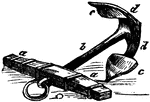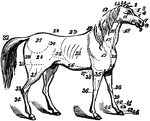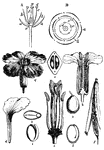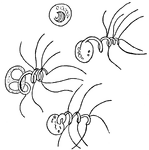
Custard Apple
Custard apple (Anona reticulata). 1, flower, three outer petals removed; 2, fruit and section.

Anchor
An anchor which is an instrument used for retaining a ship in a particular spot. a, a, stock; b, shank;…

Horse
The anatomy of a horse. 1, ears; 2, forelock; 3, forehead; 4, eyes; 5, eye-pits; 6, nose; 7, nostril;…

Structure of a Flower
Flower anatomy. A, sectional view of a flower showing the vertical disposition of whorls. a, sepal of…

Polar Bear Leg
The anatomy of a polar bear's leg. a, femur (thigh); b, tibia (leg); c, tarsus and metatarsus (foot);…

Saint Matthew Writing
Saint Matthew sitting an a cloth-covered table writing the Gospel. The Holy Spirit, represented as a…

Semisagittate Mark
"In entomology, shaped like the longitudinal half of a barbed arrow-head, or like the barbed end of…

Shackle Joint from the Exoskeleton of a Siluroid Fish
"A joint involving the principle of the shackle. Specifically, in anatomy, a kind of articulation found…
Ryegrass Leaf with Sheath
Lolium perenne. A sheath, in botany is "the part of an expanded organ that is rolled around a stem or…

Bones of the Shoulder and Upper Extremity - Front View
"A, acromion; C, coracoid; CA, carpus; CL, clavicle; H, humerus; M, metacarpals; O, ventral surface…

Peanut Worm - Interior Anatomy of Adult
Sipunculus nudus. A species of unsegmented marine worm, commonly called the peanut worm. "A, One fourth…

Peanut Worm - Interior Anatomy of Larva
Sipunculus nudus. A species of unsegmented marine worm, commonly called the peanut worm. "B, Larval…

Hand Sled or Sledge
"1. A drag or dray without wheels, but mounted on runners, for the conveyance of loads over frozen snow…

Speaking Trumpet
"A trumpet-shaped instrument by which the sound of the human voice is reinforced so that it may be heard…

Spermatozooid of the Southern Maidenhair Fern and Venus Hair Fern
Spermatozooid, mature male germ cells, of Adiantum capillus-veneris. Also called spermatozoid.
Human Spermatozoa
"One of the numberless microscopic bodies contained in semen, to which the seminal fluid owes its vitality,…

Spirometer
"A contrivance for measuring the extreme differential capacity of the human lungs. The instrument most…
